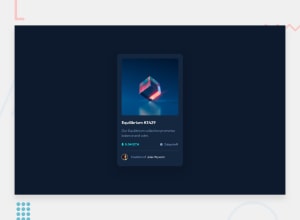
Design comparison
Solution retrospective
For the image overlay. Is there a way to change or control the fill color of a background image SVG so for example:
background-image: url("link to some svg file");
When I used this and lowered the opacity of the parent element, the white color of the SVG eye image also lowered in opacity. So, I tried to research and find if the SVG's fill color could be changed while being used as a background-image and found nothing. So, I would have to assume there isn't a way? In the end I ended up using a second div and image tag to hide and show when hovered on.
Any other feedback is always appreciated, thanks for viewing
Community feedback
- @PhoenixDev22Posted over 2 years ago
Hello MURRAY122,
Great work! Congratulation on completing this challenge. I have some suggestions regarding your solution if you don't mind:
- Since there's a :hover state on the image and means it's interactive, So there should be an interactive element around it. When you create a component that could be interacted with a user , always remember to include interactive elements like(button, textarea,input, ..) For this imagine what would happen when you click on the image, there are two possible ways:
1: If clicking the image would show a popup where the user can see the full NFT, here you use
<button>.2:If clicking the image would navigate the user to another page to see the NFT, here use
<a>.- Also use
<a>to wrapJules Wyvern and Equilibrium #3429.
- The link wrapping the equilibrium image (
image-equilibrium) should either haveSr-onlytext, anaria-labelthat indicates where the link navigate the user(not describes the image).
- Never use
<div>and<span>alone to wrap a meaningful content. Just keep in mind that you should usually use semantic HTML in place of the div tag unless none of them (the semantic tags) really match the content to group together. By adding semantic tags to your document, you provide additional information about the document, which aids in communication. Here you can use<p class="section__content__desc">Our Equilibrium collection promotes balance and calm.</p>
- For any decorative svgs, each svg tag should have
aria-hidden="true"andfocusable=”false”attributes to make all web assistive technologies such as screen reader ignore those svgs in(icon-view, icon-ethereum, icon-clock).
- If you wish to draw a horizontal line, you should do so using appropriate CSS. You may remove the
<hr>, you can useborder-top:to the avatar's part.
- You can use unordered list
<ul>to wrapclass="section__content__details-flex". In each<li>should be<svg>and<p>, then you may use flex properties to align them centrally.
- The avatar's alt should not include the word
pictureorphoto. You can use only the creator's nameJules Wyvern. Read more how to write an alt text .
- To use more semantic tags , you may use
<figure>and<figcaption>for the avatar's part.
- Adding
rel="noopener"orrel="noreferrer"totarget="_blank"links. When you link to a page on another site using target=”_blank” attribute , you can expose your site to performance and security issues.
- There are so many ways to add the hover effect on the image , The one I would use, using pseudo-elements to change the teal bg color to a hsla. Then opacity can be changed from 0 to 1 on the pseudo element on hover. There is no need for a extra clutter in the HTML.The icon view does not really need to be in the HTML as there is no need for an extra clutter in the HTML. You can have a look at my solution here, it might help.
Aside these, your solution looks good. Hopefully this feedback helps
Marked as helpful1@MURRAY122Posted over 2 years agoThank you for your feedback, its much appreciated. I did like the pseudo-elements approach you suggested, so implemented it. Thanks again
1@PhoenixDev22Posted over 2 years ago@MURRAY122 Glad it was helpful. Happy coding!
0 - @DavidMorgadePosted over 2 years ago
Hey hello Murray, congrats on finishing the challenge! your NFT looks pretty good!
To answer the question, in this case I think that you used the best and easiest approach, getting a div to show and hide on hover.
But in terms of curiosity, you can change the params from a SVG img editing the source code inside of it, take it as an html tag, you can even add in-line styles like background-color.
As I said at the start, for this challenge the approach you used is the best in my opinion, so don't worry about trying to get it with other methods!
Hope my answer helped you!
1 - @CreixzPosted over 2 years ago
Hi Murray122, first of all contratulations for complete the challenge, I think you do a pretty well job and I have some suggestions regarding your solution if you don't mind:
Instead of put the
icon-viewin your html, I think its better to put in your css code, like this:.card .image::before { content: url(images/icon-view.svg); position: absolute;I saw that you use BEM's methodology, but i think that instead of this:
<div class="section__content"> <h1 class="section__content__title"><a href="#">Equilibrium #3429</a> </h1>you can use this:
<div class="section__content"> <h1 class="section__title"><a href="#">Equilibrium #3429</a></h1>because it's not necessary to repeat all the name, i saw in many post that is not a good practice. Hopefully this feedback helps.
0
Please log in to post a comment
Log in with GitHubJoin our Discord community
Join thousands of Frontend Mentor community members taking the challenges, sharing resources, helping each other, and chatting about all things front-end!
Join our Discord
